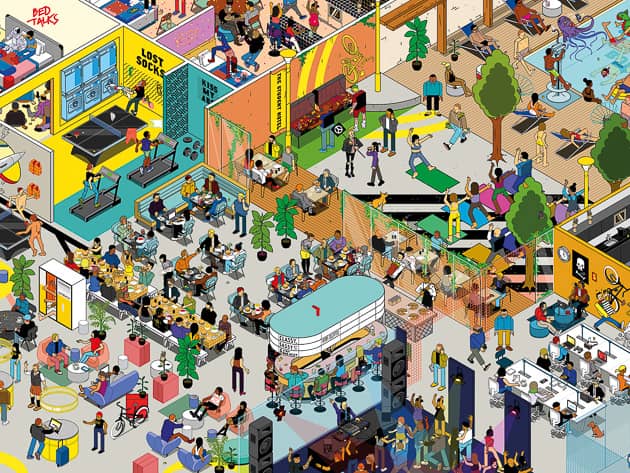
After the phenomenon of coworking, we welcome the introduction of coliving as part of the same family. Behind this new concept, we find the ingredients that contributed to the success of coworking (community, sharing, pooling and flexibility) and a similar objective: to rethink our view of property thanks to active and service-based property management. Coliving is a new generation of flat-sharing concept with the addition of hotel services. It includes a technological component that needs to meet the expectations of its primary target audience, young workers, who place heavy demands on internet connectivity and WiFi. This US-born trend may be still emerging in Europe, but has the potential to become widespread quickly.
The concept of coliving (or “shared housing”) is a clever mix of shared accommodation, hotel-style hospitality, managed residences and serviced apartments. While coworking has revolutionised the approach to commercial property, coliving wants to break the codes of residential property with its innovative approach to plug & play housing for people in transition (mainly young workers but also students and young seniors).
Coliving is a resolutely urban model which, like flatshares, relies on the pooling of shared spaces to reduce costs. It is therefore perfectly suited to large cities where property prices are sometimes a real obstacle. The flexibility of leases (from 1 month to 1 year) and administrative simplicity (say goodbye to never-ending paperwork) help facilitate easy access to accommodation, regardless of circumstances.
A service-oriented logic is the driving force behind this new integrated housing solution, demonstrated through all-inclusive rent (covering water, energy, cleaning, laundry, WiFi and even home insurance) in exchange for a fully equipped private apartment and access to common areas.
What really sets coliving apart though, is that it fosters a spirit of belonging to a community of "colivers", with internal events organised regularly to promote social ties. A full range of on-site services (café-restaurant, gym, coworking space, concierge, etc.) can also complete the coliving accommodation model.
 Illustration of the community aspect at The Student Hotel © thestudenthotel.com
Illustration of the community aspect at The Student Hotel © thestudenthotel.com
When analysing the specifics of coliving, it is difficult not to see the similarities with student residences and assisted living facilities, concepts that have been well established for many years. Can we then consider coliving to be a fully-fledged revolution? Isn’t this just a more luxurious version of managed residences?
Coliving seems to be positioning itself as a new form of managed residence aimed at younger workers (or people “in transition”), sandwiched somewhere between student residences and senior residences, a segment that has not really been catered for until now. Its value proposition seems suited to its target, as do the associated prices. Students could also relate to the concept of coliving, however the rent may seem a little high for their budget. In practice, three trends are developing in the coliving segment:
The development of coliving has given rise to the creation of specialised players such as The Outsite Coliving in Lisbon which is one of the largest coliving spaces in Portugal, housing more than 30 en-suite bedrooms, as well as several common kitchen facilities.
For another case, Coconat, is an impact driven company in Germany, wich base their value on the positive impact rather than capital growth (through innovative model of tourism, witch combines workation, coworking, coliving, and special projects focusing on rural development). More student housing operators are now looking at the coliving market. The Fizz has expanded its offering to young professionals in addition to students in Germany or in the Netherlands for example. The Student Hotel, which currently provides short-term accommodation to non-students, is looking to expand its audience with new sites across the region. It shows how the student accommodation market evolves to adapt to the rise of coliving.
Coliving is also inspiring operators of hotels and serviced residences on their path to modernisation. The hospitality sector had already begun this transformation, for example with the emergence of coworking in hotels. On closer inspection, one might wonder if coliving could also be considered a derivative of the concept of an apartment hotel? For example, Mama Shelter has opened a new establishment in Luxembourg, which will be the first to integrate a Mama Works, the group’s coworking space brand, which usually operates in spaces independent of hotels. In the student sector, coliving represents a threat and results in a need to adapt services on offer, to avoid being left behind.
Concerning the hotel residence, Novovento (which is Youth Hostel most of the year) located on the Azores island of São Miguel adopts coliving for the summer time. The place offers a relaxing environment to work for the “digital nomads” who wants to travel. We can also quote the Hotel Schani Wien which leads the way, as the first coworking hotel in Europe dedicated to the international travellers.
This model - Station F - is unique. The largest campus community space in the world (34,000 m2) is much more than a huge workspace to bring together promising start-ups. La Felicità, Station F has a unique catering offer, to the delight of businesses hosted onsite. Recently, the Flatmates complex has been added to Station F’s offer, providing an “accommodation” component in a coliving mode with 100 apartments intended to be shared by entrepreneurs.
Analysing it from another angle, we also find that within this niche segment, there are several types of residence that differ with regard to the following criteria:
Stonup, for its part, mapped out the coliving sector in 2018 (full study available here in french) using 5 orientations: community, lifestyle, mobility, work and cost.
A few examples to illustrate the variety already present in the coliving segment:

1 / The Student Hotel is a forerunner in the international coliving market. The first establishment was opened in 2012 with the desire to create a new form of hospitality for students. Today, contrary to what its name might suggest, The Student Hotel promotes a concept of "hybrid hospitality" and is no longer limited to long-stay students. TSH establishments also welcome business travellers, tourists, workers and anyone who would like to take advantage of the services on offer. It is at the same time a hotel, a student residence and a coworking space, with seminar rooms and leisure areas (restaurant, bar, swimming pool, etc.).

2 / Outsite is an international coliving player with a particular focus on professionals who work remotely: telecommuting employees, freelancers, creatives, etc. It is part of the development of this new form of work, which is still in a phase of rapid expansion today. Outsite creates unique environments for living (coliving), working (coworking) and creating human relationships (community). Thanks to its global network, Outsite also reaches a more nomadic clientele who want to live and work where they want, while at the same time meeting new people.

3 / Sun and Co brings the real feeling to be at home with family or friends. Based on the East coast of Spain, the space offers true Spanish city life, the ocean and plenty of access to nature. The focus here is on professional and personal development (weekly meetings, skill exchanges, goal setting). It is an opportunity for clients to immerse themselves in their work or personal projects in a pleasant environment.
An integral part of the all-inclusive rent, WiFi in coliving spaces is an element on which property operators should not compromise. Housing and connectivity have become inseparable, and the trend is unlikely to reverse.
As the European leader in managed WiFi in all sectors of collective accommodation, we are well placed at Wifirst to know that connectivity has become a critical element contributing directly to guest satisfaction, whether in short-stay or long-stay accommodation formats. Etienne Détrie, Marketing Director at Wifirst
The new trends in content consumption demand ever-greater bandwidth. This is particularly the case with the proliferation of mobile devices, the boom in OTT services and the emergence of cloud gaming. Some coliving operators even offer Netflix and Spotify subscriptions to each tenant.
At the same time, the IoT is spreading in homes. We speak of Smart Homes or even of “connected rooms” in more of a hotel context. Beyond entertainment-related applications (Smart TV, Chromecast, WiFi speakers, Smartwatches, etc.), this becomes all the more concrete when we add home automation that will optimise energy consumption and the safety and comfort of housing through automation and remote control.
WiFi connectivity is also an essential part of the common areas within coliving residences, especially when a coworking space is included, as bandwidth requirements and user density are generally high. Network access modes must also be varied to meet the needs of different types of customers:
Equipping a student residence with WiFi requires real expertise, as does equipping a coworking space. Both of these types of establishment also require very robust internet access because it will be seriously put to the test. In short, coliving residences must equip themselves with state-of-the-art network infrastructure to offer a high-quality service. Vincent Guilbeau, Director of Operations at Wifirst
These Stories on Hotel Industry
A leader in innovative WiFi and Fibre connectivity solutions since 2002, Wifirst is trusted by thousands of customers across Europe to provide high-quality, robust networks.